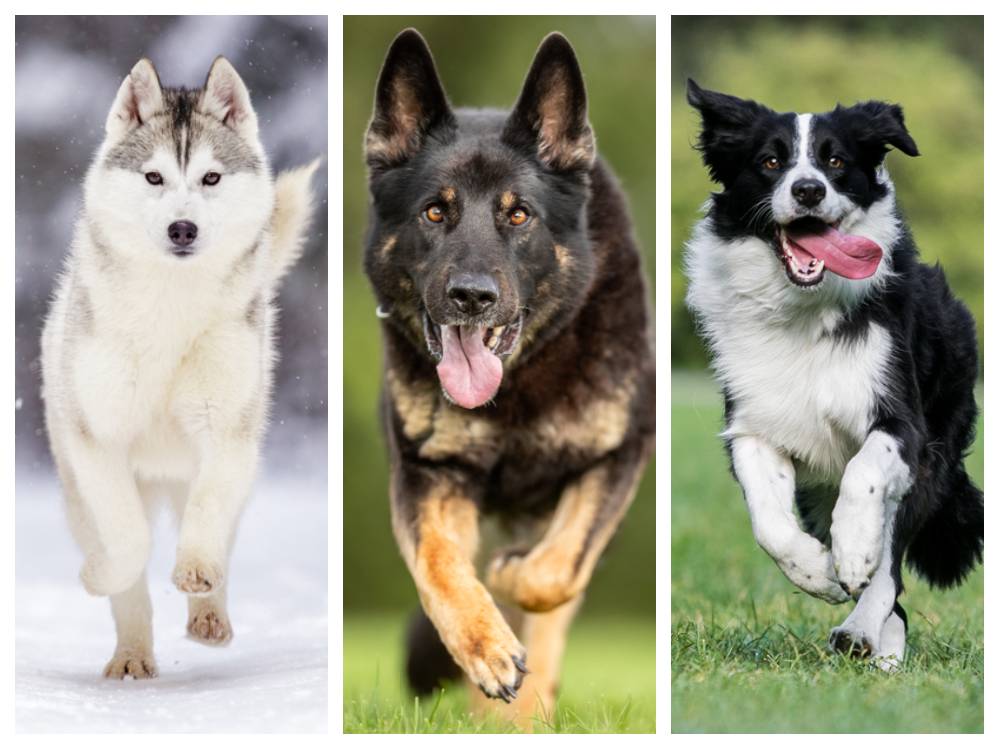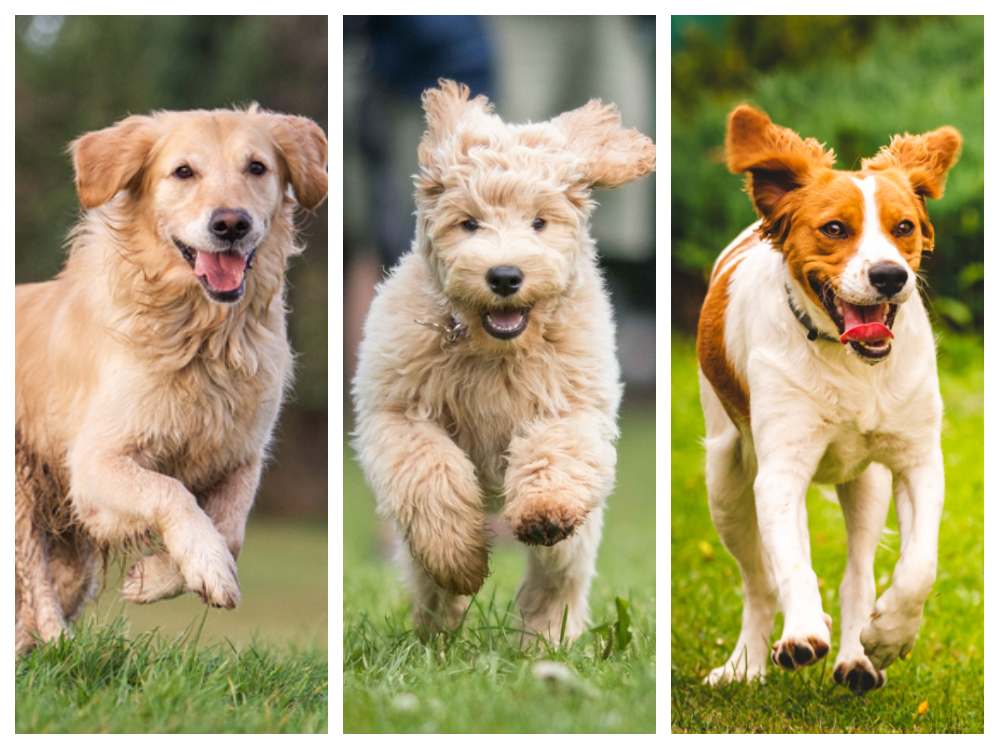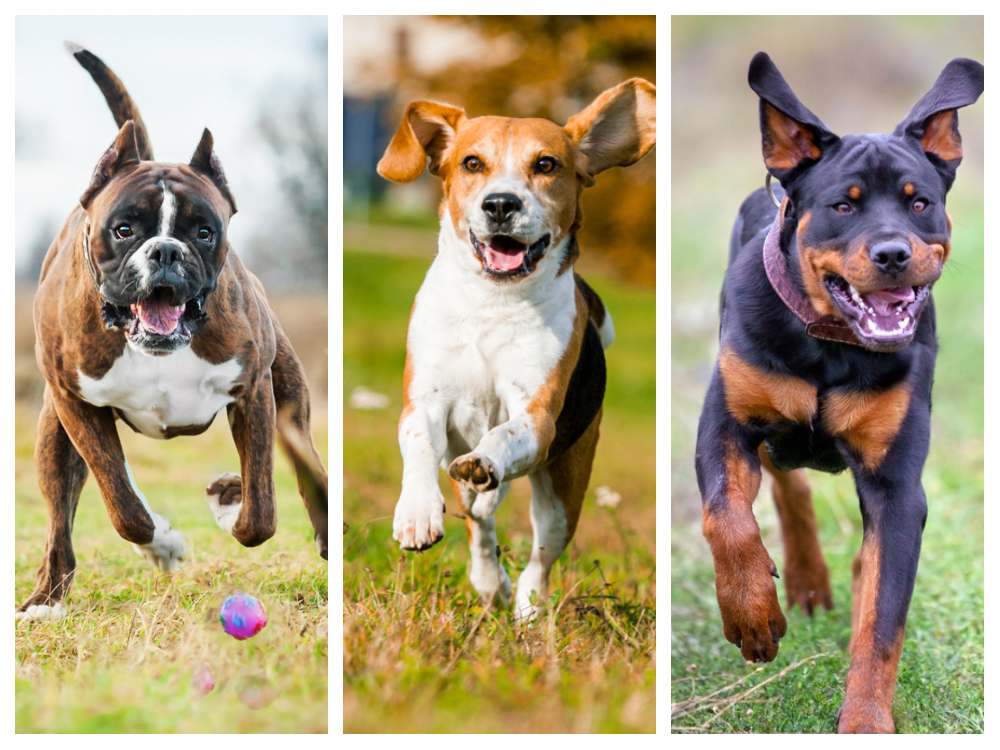
This article was updated on March 8th, 2023
Runners, joggers, sprinters, marathoners… come in all shapes and sizes. Depending on their age, body type, training, and weather conditions, they may or may not run efficiently let alone enjoyably. Dogs are no different. Although training can be achieved through consistent workouts and extreme weather can be avoided, a dog’s age and body type (breed) are set in stone and are critical in determining how far your dog can run. Regardless of any other factors, it is imperative that you visit your vet before running with your dog. After all, if health professionals recommend that you get a health screening before starting an exercise program, your dog deserves the same. If there are any existing health or weight issues, your vet is the one to turn to for advice.
Dog breeds who can do long-distance runs (5+ miles, half and full marathon)

Distance running obviously requires stamina. Dogs with hunting and herding instincts meet that requirement easily. Beagles, Jack Russells, and Corgis fit that bill, but they also have short legs and might not be the best choice for marathon running.
Dog breeds with the endurance to run that 13.1 or 26.2 mile distance (with careful training and endurance building) include:
- Hunting Dogs: Labrador, Pointer, Vizsla, Weimaraner
- Herding Dogs: Australian Shepherd, Belgian Malinois (shepherd), Border Collie, Cattle Dog, Kelpie
- Working Dogs: Dalmatian, German Shepherd, Husky, Malamute, Rhodesian Ridgeback, Standard Poodle
Dog breeds who can do medium-distance runs (5 – 10 miles)

Some dogs can easily cross over from one distance to another. In addition to the dogs listed above, the best medium-distance runners include:
- Brittany Spaniel, Dobermans, Doodles (Labra or Golden, provided they are standard size rather than mini), English Setter, Golden Retriever, Pitbull (5-7 miles), Shetland Sheepdog, and Staffordshire Terrier
Dog breeds best suited for short-distance runs (1 to 5 miles)

Again, there is always some crossover, so add to the above:
- Beagles: 2-5 miles
- Boxers: 2-3 miles
- Corgis: 1-2 miles
- French bulldogs: less than 1 mile
- Jack Russell Terrier: 5 miles
- Rottweilers: 2 miles at slow speed
Best dog breeds for sprinting
The Greyhound and the Whippet are the Usain Bolts of the canine kingdom. While none can compete with them in speed, they are not distance runners.
Steps to take before you run long distance with your dog
Once your dog has been cleared by a vet and you’ve chosen an appropriate distance, you’ll need to gather some supplies for the adventure.
- Fresh water: This can be carried in any container that is convenient for you. Check out collapsible dog bowls that clip on a leash or backpack. Some water bottles/feeders are made specifically for dogs on the go.

- A strong leash: It goes without saying that you need a leash. Get a strong one that can protect your dog from danger if need be, and check it from time to time to make sure it’s intact. You might consider a hands-free model. You want a running dog, not a run-away dog!
- A harness: When running alongside you, your dog will be much more comfortable with a harness rather than a collar as a harness avoids pressure on the neck. It will also offer you greater control should you need it.
How can you train your dog to run with you? How long does it take?
The key word here is ‘train.’ Training is a process of teaching and developing the skills and knowledge needed in order to perform the desired task. Yes, dogs run naturally, however, running with someone might need to be taught. What does your dog already know?
1. Walking on a lead
Leash training is critical to your success. Your pooch needs to know enough to stay with you and not pull on the lead. It will take a bit of time and repetition, but this step shouldn’t be skipped.
A short leash is best to start with. Pups need to learn both their and your position so that no one gets tangled and trips. Traditionally, a dog walks to your left, but either side is fine as long as you are consistent.
They also need to learn to walk at your pace, not ahead of or behind you. As always, treats are a great motivation to do things correctly.
2. Basic commands
Take the time to ensure your dog will obey basic commands. ‘Sit’ and ‘Stay’ are critical for traffic crossings. ‘Leave it’ or ‘No’ will come in handy should your dog be tempted to pick something up or spot a squirrel. The time you spend on this will pay off in the long run. (pun intended!)
3. Start off slowly
Once your dog is adept at leash walking, begin walking faster and intersperse your training with slow, short jogs. Increase the time and distance gradually both for pace training and your dog’s conditioning.
4. Practice directions
Help your dog understand changes of direction and U-turns.
5. Add sprints and short runs
Gradually add sprints and short runs. Mix walks with runs and increase time and distance as your dog’s endurance improves.
6. Teach speed cues
A cue can be anything from the actual word to a hand motion to a whistle, as long as both you and your dog agree on what it means. Taking the time to teach some cues for ‘walk’ vs. ‘run’ will help your dog to know what’s coming and adjust their pace to yours.
7. Vary your training
Variation in training not only prevents boredom, but it also allows you to exercise muscles differently and perhaps ward off overuse or injury.
Creating a workout program
If you’ve followed the steps above, you are ready to develop a workout program. It’s time to condition your dog for longer runs. This will depend entirely on you and your individual canine running partner. It may take some trial and error, but always err on the side of safety. It’s better to do too little than too much. Remember to gradually increase time and distance.
Monitor your dog during a run
Always keep an eye on your dog while you are running. In an effort to please you, your pooch may attempt to hide an injury. You’ll also need to be aware of signs of exhaustion or overheating. Take note of the dog’s general appearance and watch for signs of hyperthermia on hot days. Should you run with a Labrador retriever, curly coated retriever, Chesapeake Bay retriever, German wirehaired pointer, cocker spaniel, Boykin spaniel, Bouvier des Flander, Old English sheepdog, or Pembroke Welsh corgi, be aware of a condition called exercise-induced collapse, which may cause your dog to suddenly collapse during a strenuous activity.
In order to please you, your dog will always be ready to go. It’s up to you to provide the rest and recovery your pooch needs. It’s best to alternate running days for just that reason.
Signs you need to stop
If your dog is hyperventilating, lagging behind, or stops altogether, it’s time for a break. It may just be an off day or for weather conditions, but be open to adjusting your training routine if necessary.
How does the weather affect my dog’s running?
The best climate for training or running your dog is a moderate one—no extreme temperatures or weather conditions. If you’re uncomfortable, then your dog will be too.
- Lows: A cool, crisp day with a snap in the air is invigorating for both you and your dog, and temps above 20ºF are great for short distance runs. Below that you’ll need to limit their time outdoors, and by no means should your dog run when the temperature is below freezing. Obviously, huskies and malamutes are ideal for cold-weather running.
If you live in a snowy area, you may need to invest in snow boots to protect your dog’s pads from snow, ice, and chemicals used as deicers.
If all else fails, find an indoor dog park or exercise your pup at home with simple games of fetch and tug. Some dogs will even use a treadmill!
- Highs: High temperatures are even more dangerous for your dog than they are for you simply because your dog has very few sweat glands. Only their paws sweat and their primary means of cooling themselves is by panting. Your canine running partner can overheat easily in temps starting at 70ºF (20ºC), and long runs should be avoided completely at or above 75ºF.
Summer runs are best taken in the early morning or late evening. Remember that surfaces such as asphalt and concrete can absorb and retain enough heat to blister your dog’s paws.
Rhodesian Ridgebacks and Fox Terriers do well in warmer climates, but will still need a watchful eye.
What surface should dogs run on? Concrete, asphalt, grass, stones?
Softer surfaces, such as grass or dirt, are the easiest on your dog’s joints, whereas concrete, asphalt, and stones may cause damage to their bones and paws. Paw pads are of some use in preventing sores and abrasions.
What about running on trails?
The biggest challenges in trail running come in the form of wildlife, poisonous plants, and waterborne pathogens. Know the trails you want to run on and always be aware of your surroundings. Boots are more of a necessity due to thorns, burrs, and sharp rocks, and examine your dog afterwards for ticks and fleas.
Some of the best trail runners include the Border Collie, German Short-haired Pointer, Vizsla, and Weimaraner.
Best dog breeds for couch sitting
There are two main reasons why some dogs are not good running candidates.
- They have short legs
Obviously, dogs with short legs can still run, but they cannot keep up with you, or they might be predisposed to other health issues. Dachshunds, for example, are prone to intervertebral disc disease.
- They have short snouts
A dog with a short snout is said to be brachycephalic. Its skull bones are shorter in length than normal which gives the dog’s face a pushed in appearance. The condition can inhibit the dog’s respiration—particularly during exertion. Bulldogs, French Terriers, and even Boxers are brachycephalic, and they should be watched carefully during any exercise period.
Other dogs in this category include the Boston Terrier, Chihuahua, Chow-Chow, English Mastiff, Pekingese, Pug, Shih Tzu, and Spaniel.
FAQ
How many miles on average can a dog run?
This varies greatly depending on the individual dog. Although many dogs are capable of running 25 to 35 miles per week on average, it is important for you to determine your own dog’s limits. Always check with your vet for advice.
Do dogs make good running partners?
If trained patiently and properly, dogs can be excellent running partners. They can even inspire and encourage their humans.
Is it safe to run with your dog? Is it dangerous to run with a small dog?
Many factors enter into the safety of running with your dog. Your first stop is always your vet for advice and guidance. One of the best reference guides available for determining what your dog is capable of is Structure in Action by Pat Hastings.
What if my dog stops to sniff in the woods when running?
Although sniffing is important for dogs, it can totally ruin your run if allowed. The key is to take your dog on different types of runs/walks and teach them the difference. If your dog knows they will get a sniff walk, they will more likely cooperate on a run.
How fast can a dog run?
The average run speed of a dog has been calculated at about 15 to 20 mph. Three-year old Reas set a new world record in 2021, however. The whippet completed a 100-yard dash in 5.769 seconds, which is 35.45 mph!
Dogs in the news
In 2016, a bloodhound named Ludivine was let out to relieve himself. Upon spotting runners in a half marathon, the dog crawled under the fence and joined them! He was awarded a medal for finishing in sixth place.
Disclaimer: This website's content is not a substitute for veterinary care. Always consult with your veterinarian for healthcare decisions. Read More.


Your blog is very informative. Thank you for a comprehensive guide!